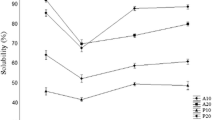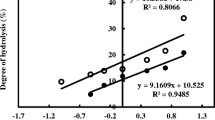Abstract
Hydrolysates from Pacific white shrimp (Litopenaeus vannamei) cephalothorax were prepared using various hydrolysis processes, and their chemical composition, characteristics as well as antioxidative activity were studied. Those processes consisted of autolysis (AU), hydrolysis using Alcalase at 0.5% (0.5A) or 1.0% (1.0A) and autolysis, followed by Alcalase hydrolysis at 0.5 and 1.0% (AU + 0.5A and AU + 1.0A). All the hydrolysate samples had higher protein contents (86.04–89.24%) and lower amounts of ash (7.46–11.26%) and lipids (0.43–0.64%), compared to those of cephalothorax (P < 0.05). The highest yield (54.04%) and protein recovery (84.15%) were observed in the AU + 1.0A sample, which had the maximum degree of hydrolysis (DH) (44.93%) (P < 0.05). All the hydrolysates had glutamic acid/glutamine (115.80–121.69 mg/g dry sample), aspartic acid/asparagine (84.04–90.28 mg/g dry sample), arginine (63.27–68.62 mg/g dry sample) and leucine (58.67–68.07 mg/g dry sample) as the dominant amino acids. Based on gel filtration chromatography, the hydrolysates with higher DH showed higher proportions of smaller peptides (< 1355 Da). When the antioxidant activities of the hydrolysates were determined, the AU + 1.0A sample had the highest ferrous ion chelating activity, ABTS radical scavenging activity and ORAC value, compared to the others (P < 0.05). However, the highest ferric reducing antioxidant activity and DPPH radical scavenging activity were obtained for the 1.0A and AU samples, respectively (P < 0.05). Furthermore, the AU + 1.0A sample showed higher inhibitory activity against DNA damage induced by peroxyl radicals than the 1.0A and AU samples. Therefore, different hydrolysis processes directly affected the protein recovery, chemical composition and antioxidant activities of the hydrolysates from shrimp cephalothorax.
Graphical Abstract



Similar content being viewed by others
References
Senphan, T., Benjakul, S.: Antioxidative activities of hydrolysates from seabass skin prepared using protease from hepatopancreas of Pacific white shrimp. J. Funct. Foods 6, 147–156 (2014)
Dey, S.S., Dora, K.C.: Antioxidative activity of protein hydrolysate produced by Alcalase hydrolysis from shrimp waste (Penaeus monodon and Penaeus indicus). J. Food Sci. Technol. 51, 449–457 (2014)
Takeungwongtrakul, S., Benjakul, S., H-kittikun, A.: Lipids from cephalothorax and hepatopancreas of Pacific white shrimp (Litopenaeus vannamei): Compositions and deterioration as affected by iced storage. Food Chem. 134, 2066–2074 (2012)
Cao, W., Zhang, C., Hong, P., Ji, H., Hao, J., Zhang, J.: Autolysis of shrimp head by gradual temperature and nutritional quality of the resulting hydrolysate. LWT - Food Science and Technology 42, 244–249 (2009)
Dey, S.S., Dora, K.C.: Optimization of the production of shrimp waste protein hydrolysate using microbial proteases adopting response surface methodology. J. Food Sci. Technol. 51, 16–24 (2014)
Sae-leaw, T., O’Callaghan, Y.C., Benjakul, S., O’Brien, N.M.: Antioxidant activities and selected characteristics of gelatin hydrolysates from seabass (Lates calcarifer) skin as affected by production processes. J. Food Sci. Technol. 53, 197–208 (2016)
Cao, W., Zhang, C., Hong, P., Ji, H.: Response surface methodology for autolysis parameters optimization of shrimp head and amino acids released during autolysis. Food Chem. 109, 176–183 (2008)
Senphan, T., Benjakul, S., Kishimura, H.: Characteristics and antioxidative activity of carotenoprotein from shells of Pacific white shrimp extracted using hepatopancreas proteases. Food Biosci. 5, 54–63 (2014)
Sowmya, R., Ravikumar, T.M., Vivek, R., Rathinaraj, K., Sachindra, N.M.: Optimization of enzymatic hydrolysis of shrimp waste for recovery of antioxidant activity rich protein isolate. J. Food Sci. Technol. 51, 3199–3207 (2014)
Sila, A., Sayari, N., Balti, R., Martinez-Alvarez, O., Nedjar-Arroume, N., Moncef, N., Bougatef, A.: Biochemical and antioxidant properties of peptidic fraction of carotenoproteins generated from shrimp by-products by enzymatic hydrolysis. Food Chem. 148, 445–452 (2014)
Senphan, T., Benjakul, S.: Compositions and yield of lipids extracted from hepatopancreas of Pacific white shrimp (Litopenaeus vannamei) as affected by prior autolysis. Food Chem. 134, 829–835 (2012)
Holanda, H., Netto, F.: Optimization of the conditions for the enzyme hydrolysis of shrimp residue, using response surface methodology (RSM). In book of abstracts. In: 2002 IFT Annual Meeting, Anaheim, CA, USA. 2002, p. 194
AOAC: Official Method of Analysis of Association of Chemistry. The Association of Official Analytical Chemists, Washigton (2000)
Saito, A., Regier, L.W.: Pigmentation of brook trout (Salvelinus fontinalis) by feeding dried crustacean waste. J. Fish. Res. Board Can. 28, 509–512 (1971)
Benjakul, S., Oungbho, K., Visessanguan, W., Thiansilakul, Y., Roytrakul, S.: Characteristics of gelatin from the skins of bigeye snapper, Priacanthus tayenus and Priacanthus macracanthus. Food Chem. 116, 445–451 (2009)
Benjakul, S., Morrissey, M.T.: Protein hydrolysates from Pacific whiting solid wastes. J. Agric. Food Chem. 45, 3423–3430 (1997)
Gennadios, A., Weller, C.L., Hanna, M.A., Froning, G.W.: Mechanical and barrier properties of egg albumen films. J. Food Sci. 61, 585–589 (1996)
Nilsang, S., Lertsiri, S., Suphantharika, M., Assavanig, A.: Optimization of enzymatic hydrolysis of fish soluble concentrate by commercial proteases. J. Food Eng. 70, 571–578 (2005)
Binsan, W., Benjakul, S., Visessanguan, W., Roytrakul, S., Tanaka, M., Kishimura, H.: Antioxidative activity of Mungoong, an extract paste, from the cephalothorax of white shrimp (Litopenaeus vannamei). Food Chem. 106, 185–193 (2008)
Kittiphattanabawon, P., Benjakul, S., Visessanguan, W., Shahidi, F.: Inhibition of angiotensin converting enzyme, human LDL cholesterol and DNA oxidation by hydrolysates from blacktip shark gelatin. LWT Food Sci. Technol. 51, 177–182 (2013)
Steel, R.G.D., Torrie, J.H.: Principles and Procedures of Statistics: A Biometrical Approach, 2nd edn. McGraw-Hill, New York (1980)
Karnjanapratum, S., Benjakul, S.: Characteristics and antioxidative activity of gelatin hydrolysates from unicorn leatherjacket skin as affected by autolysis-assisted process. J. Food Process. Preserv. 39, 915–926 (2015)
Phuong, P.T.D., Minh, N.C., Cuong, H.N., Van Minh, N., Han, N.T., Van Hoa, N., Yen, H.T.H., Trung, T.S.: Recovery of protein hydrolysate and chitosan from black tiger shrimp (Penaeus monodon) heads: approaching a zero waste process. J. Food Sci. Technol. 54, 1850–1856 (2017)
Gunasekaran, J., Kannuchamy, N., Kannaiyan, S., Chakraborti, R., Gudipati, V.: Protein hydrolysates from shrimp (Metapenaeus dobsoni) head waste: optimization of extraction conditions by response surface methodology. J. Aquat. Food Prod. Technol. 24, 429–442 (2015)
Shahidi, F., Synowiecki, J.: Isolation and characterization of nutrients and value-added products from snow crab (Chionoecetes opilio) and shrimp (Pandalus borealis) processing discards. J. Agric. Food Chem. 39, 1527–1532 (1991)
Thiansilakul, Y., Benjakul, S., Shahidi, F.: Compositions, functional properties and antioxidative activity of protein hydrolysates prepared from round scad (Decapterus maruadsi). Food Chem. 103, 1385–1394 (2007)
Armenta, R.E., Guerrero-Legarreta, I.: Amino acid profile and enhancement of the enzymatic hydrolysis of fermented shrimp carotenoproteins. Food Chem. 112, 310–315 (2009)
Yarnpakdee, S., Benjakul, S., Kristinsson, H.G., Kishimura, H.: Antioxidant and sensory properties of protein hydrolysate derived from Nile tilapia (Oreochromis niloticus) by one- and two-step hydrolysis. J. Food Sci. Technol. 52, 3336–3349 (2015)
Pongsetkul, J., Benjakul, S., Vongkamjan, K., Sumpavapol, P., Osako, K., Faithong, N.: Changes in volatile compounds, ATP-related compounds and antioxidative properties of Kapi, produced from Acetes vulgaris, during processing and fermentation. Food Biosci 19, 49–56 (2017)
Hou, H., Li, B., Zhao, X., Zhang, Z., Li, P.: Optimization of enzymatic hydrolysis of Alaska pollock frame for preparing protein hydrolysates with low-bitterness. LWT Food Sci Technol 44, 421–428 (2011)
Aspevik, T., Totland, C., Lea, P., Oterhals, Å: Sensory and surface-active properties of protein hydrolysates based on Atlantic salmon (Salmo salar) by-products. Process Biochem. 51, 1006–1014 (2016)
Spellman, D., O’Cuinn, G., FitzGerald, R.J.: Bitterness in Bacillus proteinase hydrolysates of whey proteins. Food Chem. 114, 440–446 (2009)
Nalinanon, S., Benjakul, S., Kishimura, H., Shahidi, F.: Functionalities and antioxidant properties of protein hydrolysates from the muscle of ornate threadfin bream treated with pepsin from skipjack tuna. Food Chem. 124, 1354–1362 (2011)
Floegel, A., Kim, D.-O., Chung, S.-J., Koo, S.I., Chun, O.K.: Comparison of ABTS/DPPH assays to measure antioxidant capacity in popular antioxidant-rich US foods. J. Food Compos. Anal. 24, 1043–1048 (2011)
Karnjanapratum, S., Benjakul, S.: Antioxidative gelatin hydrolysate from unicorn leatherjacket skin as affected by prior autolysis. Int Aquat Res 7, 101–114 (2015)
Prior, R.L., Wu, X., Schaich, K.: Standardized methods for the determination of antioxidant capacity and phenolics in foods and dietary supplements. J. Agric. Food Chem. 53, 4290–4302 (2005)
Kittiphattanabawon, P., Benjakul, S., Visessanguan, W., Shahidi, F.: Gelatin hydrolysate from blacktip shark skin prepared using papaya latex enzyme: antioxidant activity and its potential in model systems. Food Chem. 135, 1118–1126 (2012)
Yarnpakdee, S., Benjakul, S., Kristinsson, H.G., Bakken, H.E.: Preventive effect of Nile tilapia hydrolysate against oxidative damage of HepG2 cells and DNA mediated by H2O2 and AAPH. J. Food Sci. Technol. 52, 6194–6205 (2015)
Chandrasekara, A., Shahidi, F.: Bioactivities and antiradical properties of millet grains and hulls. J. Agric. Food Chem. 59, 9563–9571 (2011)
Zhong, Y., Shahidi, F.: Lipophilised epigallocatechin gallate (EGCG) derivatives and their antioxidant potential in food and biological systems. Food Chem. 131, 22–30 (2012)
Acknowledgements
This work was supported by the government budget of Prince of Songkla University (Grant No. AGR610400S).
Author information
Authors and Affiliations
Corresponding author
Additional information
Publisher’s Note
Springer Nature remains neutral with regard to jurisdictional claims in published maps and institutional affiliations.
Rights and permissions
About this article
Cite this article
Sinthusamran, S., Benjakul, S., Kijroongrojana, K. et al. Protein Hydrolysates from Pacific White Shrimp Cephalothorax Manufactured with Different Processes: Compositions, Characteristics and Antioxidative Activity. Waste Biomass Valor 11, 1657–1670 (2020). https://doi.org/10.1007/s12649-018-0517-1
Received:
Accepted:
Published:
Issue Date:
DOI: https://doi.org/10.1007/s12649-018-0517-1




